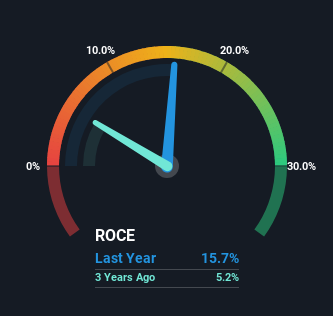- Malaysia
- /
- Energy Services
- /
- KLSE:DAYANG
There Are Reasons To Feel Uneasy About Dayang Enterprise Holdings Bhd's (KLSE:DAYANG) Returns On Capital

To find a multi-bagger stock, what are the underlying trends we should look for in a business? In a perfect world, we'd like to see a company investing more capital into its business and ideally the returns earned from that capital are also increasing. Put simply, these types of businesses are compounding machines, meaning they are continually reinvesting their earnings at ever-higher rates of return. However, after briefly looking over the numbers, we don't think Dayang Enterprise Holdings Bhd (KLSE:DAYANG) has the makings of a multi-bagger going forward, but let's have a look at why that may be.
What Is Return On Capital Employed (ROCE)?
If you haven't worked with ROCE before, it measures the 'return' (pre-tax profit) a company generates from capital employed in its business. Analysts use this formula to calculate it for Dayang Enterprise Holdings Bhd:
Return on Capital Employed = Earnings Before Interest and Tax (EBIT) ÷ (Total Assets - Current Liabilities)
0.16 = RM327m ÷ (RM2.5b - RM425m) (Based on the trailing twelve months to December 2023).
Thus, Dayang Enterprise Holdings Bhd has an ROCE of 16%. In absolute terms, that's a satisfactory return, but compared to the Energy Services industry average of 9.6% it's much better.
View our latest analysis for Dayang Enterprise Holdings Bhd

In the above chart we have measured Dayang Enterprise Holdings Bhd's prior ROCE against its prior performance, but the future is arguably more important. If you'd like, you can check out the forecasts from the analysts covering Dayang Enterprise Holdings Bhd for free.
The Trend Of ROCE
On the surface, the trend of ROCE at Dayang Enterprise Holdings Bhd doesn't inspire confidence. Around five years ago the returns on capital were 20%, but since then they've fallen to 16%. Although, given both revenue and the amount of assets employed in the business have increased, it could suggest the company is investing in growth, and the extra capital has led to a short-term reduction in ROCE. And if the increased capital generates additional returns, the business, and thus shareholders, will benefit in the long run.
On a side note, Dayang Enterprise Holdings Bhd has done well to pay down its current liabilities to 17% of total assets. So we could link some of this to the decrease in ROCE. Effectively this means their suppliers or short-term creditors are funding less of the business, which reduces some elements of risk. Since the business is basically funding more of its operations with it's own money, you could argue this has made the business less efficient at generating ROCE.
The Bottom Line
Even though returns on capital have fallen in the short term, we find it promising that revenue and capital employed have both increased for Dayang Enterprise Holdings Bhd. And long term investors must be optimistic going forward because the stock has returned a huge 249% to shareholders in the last five years. So while the underlying trends could already be accounted for by investors, we still think this stock is worth looking into further.
One more thing, we've spotted 1 warning sign facing Dayang Enterprise Holdings Bhd that you might find interesting.
While Dayang Enterprise Holdings Bhd isn't earning the highest return, check out this free list of companies that are earning high returns on equity with solid balance sheets.
New: Manage All Your Stock Portfolios in One Place
We've created the ultimate portfolio companion for stock investors, and it's free.
• Connect an unlimited number of Portfolios and see your total in one currency
• Be alerted to new Warning Signs or Risks via email or mobile
• Track the Fair Value of your stocks
Have feedback on this article? Concerned about the content? Get in touch with us directly. Alternatively, email editorial-team (at) simplywallst.com.
This article by Simply Wall St is general in nature. We provide commentary based on historical data and analyst forecasts only using an unbiased methodology and our articles are not intended to be financial advice. It does not constitute a recommendation to buy or sell any stock, and does not take account of your objectives, or your financial situation. We aim to bring you long-term focused analysis driven by fundamental data. Note that our analysis may not factor in the latest price-sensitive company announcements or qualitative material. Simply Wall St has no position in any stocks mentioned.
About KLSE:DAYANG
Dayang Enterprise Holdings Bhd
An investment holding company, provides offshore topside maintenance services, minor fabrication works, and offshore hook-up and commissioning services to the oil and gas companies in Malaysia.
Flawless balance sheet established dividend payer.
Market Insights
Community Narratives



